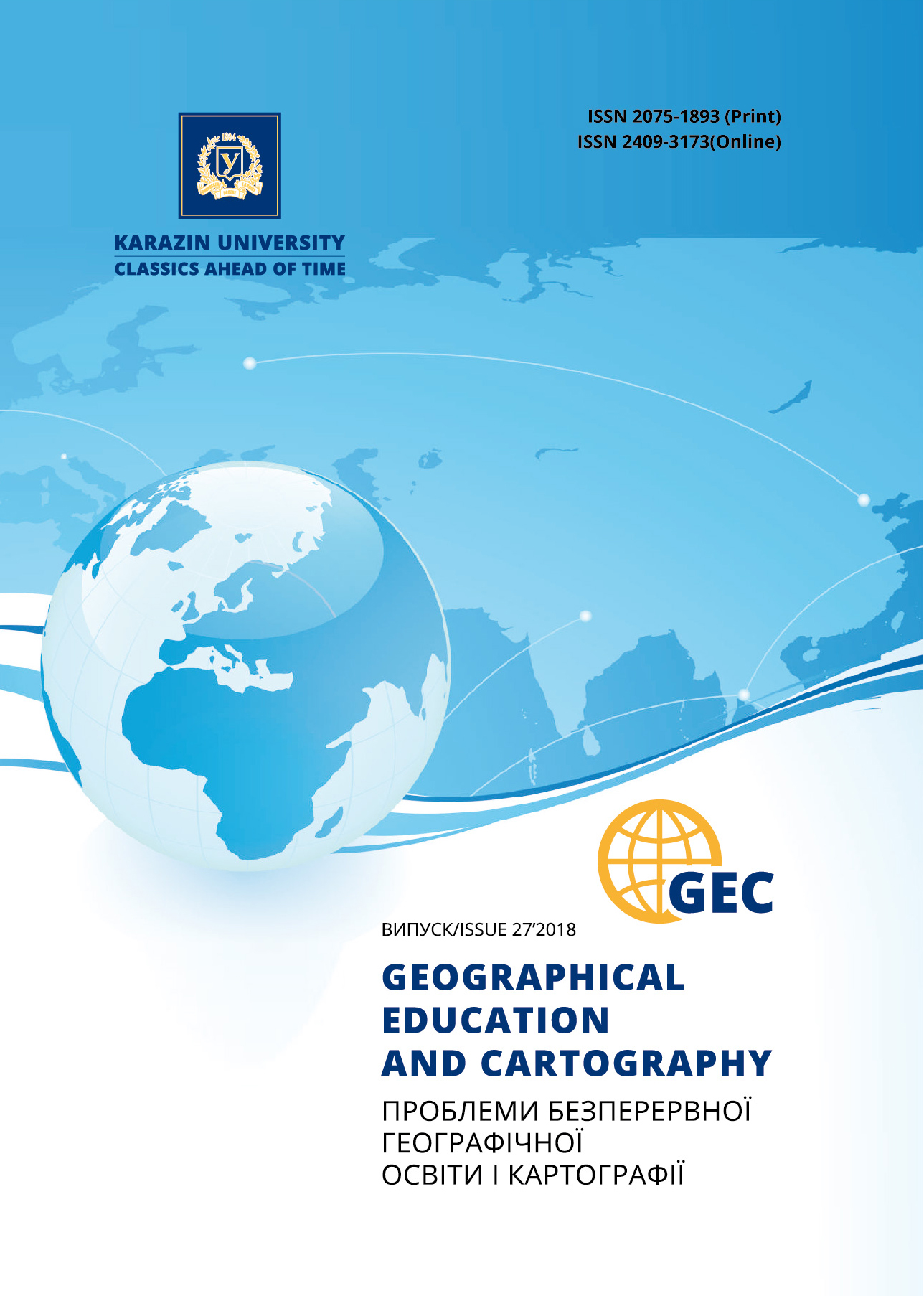Аналіз забудови та функціонального зонування міст Заполяр’я Росії, виділених за космічними знімками
Анотація
Роботу присвячено вивченню особливостей забудови та функціонального зонування найбільших міст російського Заполяр’я: Апатитів, Воркути, Мурманська і Норильська. У якості вихідних матеріалів використані знімки із супутників SPOT-5 (оптичний спектральний діапазон), Landsat 8 (тепловий спектральний діапазон) і генеральні плани досліджуваних міст, які послужили основою для виділення типів забудови. Облік теплової структури міських територій при аналізі їх забудови та функціонального зонування дозволяє виявити риси міського простору, які не видно на знімках в оптичному діапазоні, важливі в оцінці сприятливості міського середовища для життя людей.
Завантаження
Посилання
Baldina, E.A., Grishhenko, M.Yu. (2015). Metodika deshifrirovanija raznovremennyh kosmicheskih snimkov v teplovom infrakrasnom diapazone [The method of thermal infrared multitemporal satellite images interpretation]. MSU Bulletin. Series: Geography, 3, 35–42.
Belenko, V.V. (2017). Vyjavlenie struktury i izmenenij zastrojki po kosmicheskim snimkam dlja celej kartografirovanija v ramkah gradostroitel’stva [Identification of the structure and changes of the urban development using satellite images for urban planning mapping]. Natural and technical sciences, 8, 50–55.
Grishhenko, M.Ju. (2015). Metodika deshifrirovanija teplovyh kosmicheskih snimkov dlja kartografirovanija prirodnyh i antropogennyh territorij: Avtoref. dis. … kand. geogr. nauk: 25.00.33 [Method of thermal infrared satellite images interpretation for mapping natural and anthropogenic territories: Thesis abstract of candidate … geographical sciences]. Moskva: MGU, 24.
Grishhenko, M.Yu., Ermilova, Yu.V. (2018). Kartografirovanie zastrojki krupnejshih gorodov rossijskogo Zapoljar’ja po kosmicheskim snimkam raznyh spektral’nyh diapazonov [Mapping of the built-up areas of Russian Arctic biggest cities using satellite imagery of various spatial resolution]. Geodesy and cartography, 79 (3) 23-34.
Kravcova, V.I., Erlich, V.A. (2013). Kartografirovanie struktury zastrojki territorij, prisoedinjaemyh k Moskve [Mapping of the development structure of territories annexed to Moscow]. Geodesy and cartography, 6, 23–32.
Evdokimov, Yu.A., Backih, Yu.M. (2002). Severnyj morskoj put’: problemy, vozmozhnosti, perspektivy vozrozhdenija [Northern Sea Route: problems, opportunities, prospects for revival]. Economic science in modern Russia, 2, 101-112.
Marchukov, V.S., Chemal, D.A. (2013). Avtomatizirovannoe vyjavlenie izmenenij na zastroennyh territorijah Severnogo Iraka po mnogozonal’nym kosmicheskim snimkam [Automated detection of changes in the Northern Iraq built-up areas using multispectral satellite images]. News of universities. Geodesy and aerial photography, 5, 74–77.
Pavlenko, V.I. (2013). Arkticheskaja zona Rossijskoj Federacii v sisteme obespechenija nacional’nyh interesov strany [Arctic territories of Russian Federation in the supporting system of national interests]. The Arctic: ecology and economy, 4, 16–25.
Sevast’janov, D.V., Isachenko T.E. (2014). Geojekologicheskie osobennosti i sovremennoe rekreacionnoe osvoenie Noril’skogo regiona RF [Geoecological features and modern recreational development of the Norilsk region of the Russian Federation]. Tsarskoye Selo readings, XVIII, 250-253.
Hajbrahmanov, T.S. (2014). Kartograficheskaja baza dannyh dlja obespechenija jekologo-geohimicheskih issledovanij gorodskoj territorii: Avtoref. dis. ... kand. geogr. nauk: 25.00.33 [Cartographic database for supporting environmental-geochemical surveys of urban territory: Thesis abstract of candidate … geographical sciences]. Moskva: MGU, 24.
Chufarova, N.E. (2012). Fraktal’nyj analiz rajonov gorodskoj zastrojki na snimkah v teplovom IK-diapazone [Fractal analysis of urban areas in the thermal IR range]. News of universities. Geodesy and aerial photography, 1, 62–67.
Matthias, B., Martin, H. (2003). Mapping imperviousness using NDVI and linear spectral unmixing of ASTER data in the Cologne-Bonn region (Germany). Proceedings of the SPIE 10th International Symposium on Remote Sensing, 8–12 September 2003, Barcelona, Spain, 1–11.
Esau, I., Miles, V. (2016). Warmer urban climates for development of green spaces in northern Siberian cities. Geography. Environment. Sustainability, 04 (09), 48–62.
Kemmouche, A., Khedam, R., Mering, C. (2010). Mapping of built-up area density from satellite images using morphological granulometries. ISPRS TC VII Symposium – 100 Years ISPRS, Vienna, Austria, July 5–7, 2010. IAPRS, XXXVIII, 7A, 94–99.





